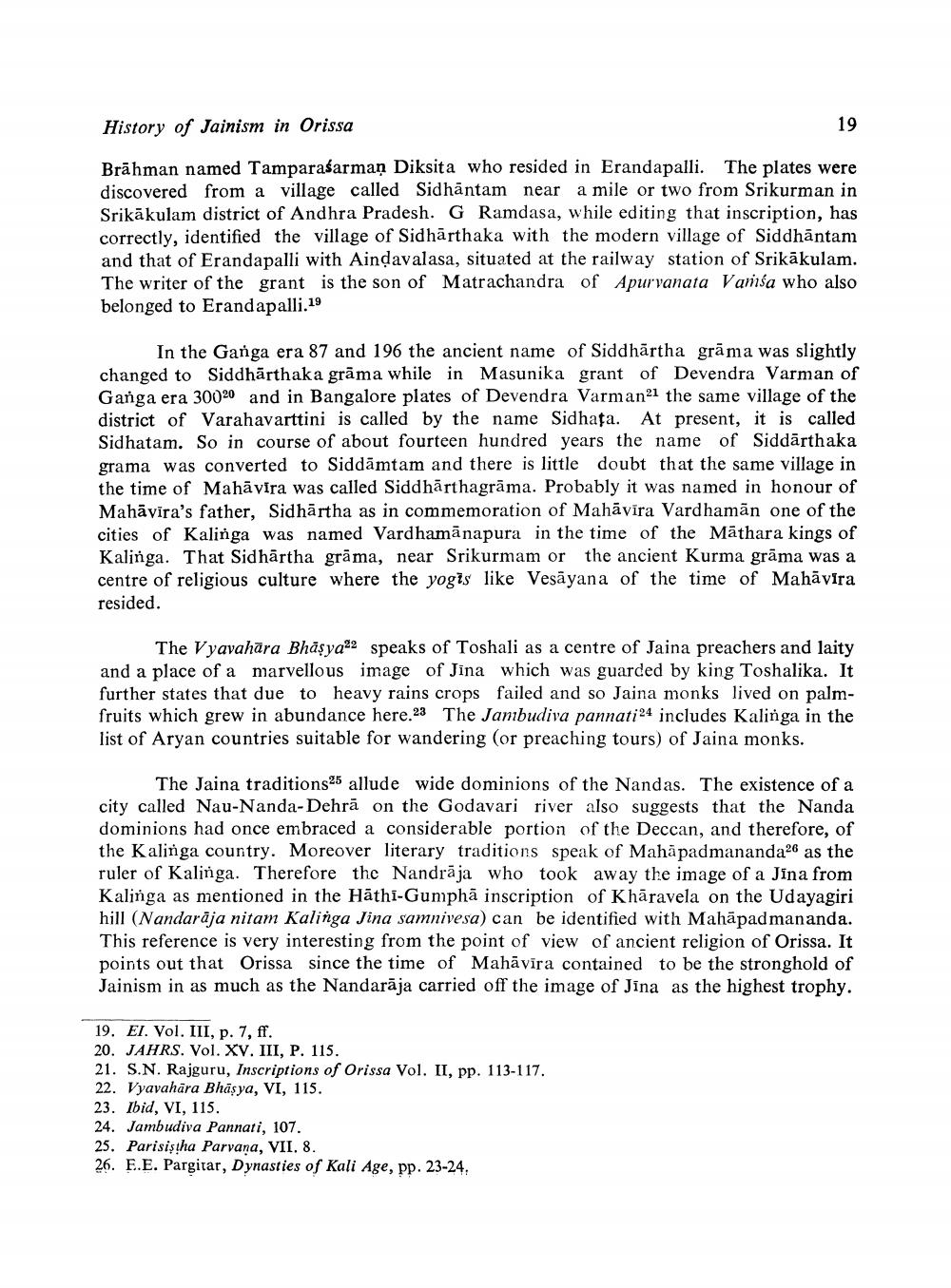________________
History of Jainism
in Orissa
19
Brāhman named Tamparaśarman Diksita who resided in Erandapalli. The plates were discovered from a village called Sidhāntam near a mile or two from Srikurman in Srikākulam district of Andhra Pradesh. G Ramdasa, while editing that inscription, has correctly, identified the village of Sidhārthaka with the modern village of Siddhāntam and that of Erandapalli with Aindavalasa, situated at the railway station of Srikākulam. The writer of the grant is the son of Matrachandra of Apurvanata Vama who also belonged to Erandapalli.19
In the Ganga era 87 and 196 the ancient name of Siddhārtha grāma was slightly changed to Siddhārthaka grāma while in Masunika grant of Devendra Varman of Ganga era 30020 and in Bangalore plates of Devendra Varman21 the same village of the district of Varahavarttini is called by the name Sidhata. At present, it is called Sidhatam. So in course of about fourteen hundred years the name of Siddarthaka grama was converted to Siddāmtam and there is little doubt that the same village in the time of Mahāvira was called Siddhārthagrāma. Probably it was named in honour of Mahāvīra's father, Sidhārtha as in commemoration of Mahāvīra Vardhamān one of the cities of Kalinga was named Vardhamānapura in the time of the Māthara kings of Kalinga. That Sidhārtha grāma, near Srikurmam or the ancient Kurma grāma was a centre of religious culture where the yogis like Vesāyana of the time of Mahāvira resided.
The Vyavahāra Bhāşya22 speaks of Toshali as a centre of Jaina preachers and laity and a place of a marvellous image of Jina which was guarded by king Toshalika. It further states that due to heavy rains crops failed and so Jaina monks lived on palmfruits which grew in abundance here.23 The Janibudiva pannati24 includes Kalinga in the list of Aryan countries suitable for wandering (or preaching tours) of Jaina monks.
The Jaina traditions25 allude wide dominions of the Nandas. The existence of a city called Nau-Nanda-Dehrā on the Godavari river also suggests that the Nanda dominions had once embraced a considerable portion of the Deccan, and therefore, of the Kalinga country. Moreover literary traditions speak of Mahāpadmananda26 as the ruler of Kalinga. Therefore the Nandrāja who took away the image of a Jina from Kalinga as mentioned in the Hāthi-Gumphā inscription of Khāravela on the Udayagiri hill (Nandarāja nitam Kalinga Jina samnivesa) can be identified with Mahapadmananda. This reference is very interesting from the point of view of ancient religion of Orissa. It points out that Orissa since the time of Mahāvīra contained to be the stronghold of Jainism in as much as the Nandarāja carried off the image of Jina as the highest trophy.
19. EI. Vol. III, p. 7, ff. 20. JAHRS. Vol. XV. III, P. 115. 21. S.N. Rajguru, Inscriptions of Orissa Vol. II, pp. 113-117. 22. Vyavahāra Bhāsya, VI, 115. 23. Ibid, VI, 115. 24. Jambudiva Pannati, 107. 25. Parisiştha Parvana, VII. 8. 26. E.E. Pargitar, Dynasties of Kali Age, pp. 23-24.




